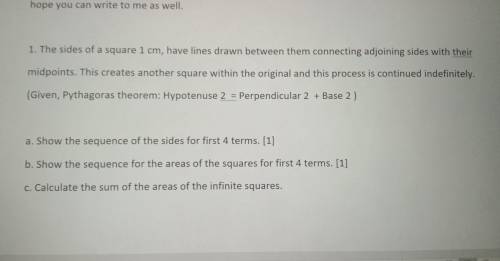
Mathematics, 31.01.2022 01:40 Kurlyash
1. The sides of a square 1 cm, have lines drawn between them connecting adjoining sides with their midpoints. This creates another square within the original and this process is continued indefinitely. (Given, Pythagoras theorem: Hypotenuse 2 = Perpendicular 2 + Base 2) a. Show the sequence of the sides for first 4 terms. [1] b. Show the sequence for the areas of the squares for first 4 terms. [1] c. Calculate the sum of the areas of the infinite squares.


Answers: 2


Another question on Mathematics

Mathematics, 21.06.2019 22:40
Afunction g(x) has x-intercepts at (, 0) and (6, 0). which could be g(x)? g(x) = 2(x + 1)(x + 6) g(x) = (x – 6)(2x – 1) g(x) = 2(x – 2)(x – 6) g(x) = (x + 6)(x + 2)
Answers: 1

Mathematics, 22.06.2019 00:00
Can someone me with this? i’m not sure what to put for my equations.
Answers: 2

Mathematics, 22.06.2019 00:20
Which of the following is equal to the square root of the cube root of 5 ? (1 point) 5 to the power of 1 over 3 5 to the power of 1 over 6 5 to the power of 2 over 3 5 to the power of 3 over 2
Answers: 1

You know the right answer?
1. The sides of a square 1 cm, have lines drawn between them connecting adjoining sides with their m...
Questions

Physics, 14.07.2019 20:20





Biology, 14.07.2019 20:20

Social Studies, 14.07.2019 20:20

Social Studies, 14.07.2019 20:20

Biology, 14.07.2019 20:20

Social Studies, 14.07.2019 20:20



Biology, 14.07.2019 20:20

History, 14.07.2019 20:20

Business, 14.07.2019 20:20

Biology, 14.07.2019 20:20

Social Studies, 14.07.2019 20:20

Biology, 14.07.2019 20:20

Mathematics, 14.07.2019 20:20

Mathematics, 14.07.2019 20:20



